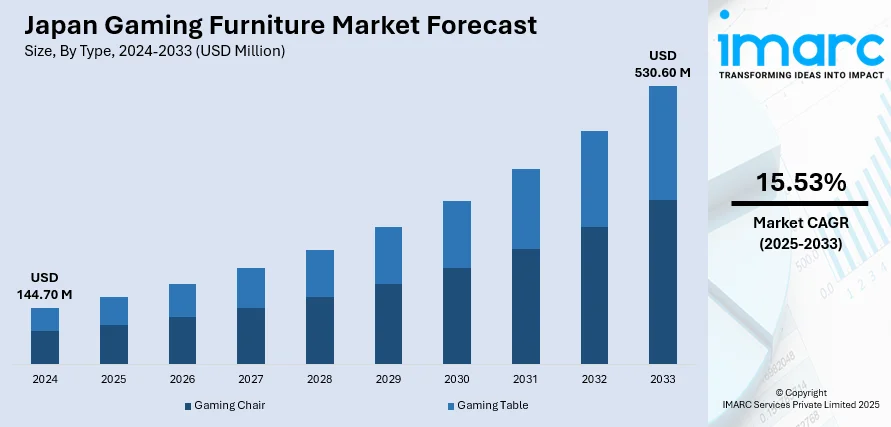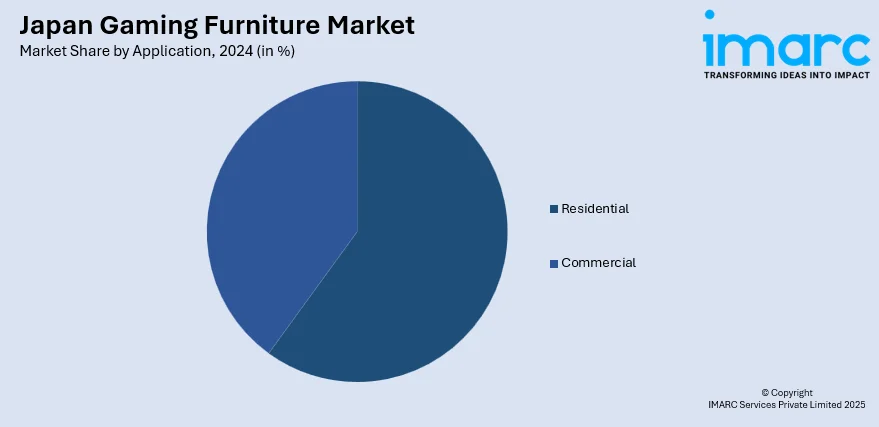
Japan Gaming Furniture Market Size, Share, Trends and Forecast by Type, Application, and Region, 2025-2033
Japan Gaming Furniture Market Overview:
The Japan gaming furniture market size reached USD 144.70 Million in 2024. Looking forward, IMARC Group expects the market to reach USD 530.60 Million by 2033, exhibiting a growth rate (CAGR) of 15.53% during 2025-2033. The sector is fueled by the growth of eSports and streaming culture, growing demand for ergonomic designs that facilitate prolonged gaming sessions, and smart technology integration. Players demand comfortable, health-focused furniture that offers features such as adjustable support. Meanwhile, technology additions such as embedded speakers, red green and blue (RGB) lighting, and wireless charging enhance immersive experiences. These collectively drive the Japan gaming furniture market share for gaming furniture as players value performance, comfort, and enhanced functionality in their setups.
|
Report Attribute
|
Key Statistics
|
|---|---|
|
Base Year
|
2024
|
|
Forecast Years
|
2025-2033
|
|
Historical Years
|
2019-2024
|
| Market Size in 2024 | USD 144.70 Million |
| Market Forecast in 2033 | USD 530.60 Million |
| Market Growth Rate 2025-2033 | 15.53% |
Japan Gaming Furniture Market Trends:
Focus on Ergonomics and Health
Japanese gamers are increasingly focused on health and comfort, driving strong demand for ergonomic gaming furniture. Long gaming sessions can lead to issues like back pain and poor posture, encouraging gamers to seek chairs and desks with features such as lumbar support, adjustable height, and breathable materials that reduce physical strain. This shift reflects a broader awareness of wellness within the gaming community. To meet these needs, manufacturers are innovating ergonomic designs that promote better posture and reduce fatigue, ensuring users can game comfortably for extended periods. Collaborations with esports teams and influencers further highlight the importance of ergonomic solutions. As a result, ergonomic furniture has become a crucial trend in Japan’s gaming furniture market, improving both performance and overall well-being during long hours of gameplay. This focus on health is reshaping consumer preferences and product development in the industry.

Rise of eSports and Streaming Culture
The increasing popularity of game streaming and eSports in Japan has made gaming a mainstream cultural phenomenon, with the esports market growing to ¥12.5 billion in 2022 and projected to hit more than ¥21 billion by 2025. This growth has made gaming not only a social but also a career activity, increasing the need for customized furniture used to play for long hours. Gamers increasingly look for chairs and desks that are both comfortable and functional to improve performance over long gaming sessions. To respond to this, manufacturers are collaborating with eSports teams and influencers in launching special product lines that cater to hardcore gamers and content creators. The Japanese gaming furniture market is fueled by this move towards competitive gaming lifestyles, with the need for ergonomic design, durability, and looks being the key to capturing the interest of consumers looking to upgrade their gaming setups and overall experience.
Integration of Smart Technologies
The integration of smart technology into gaming furniture is transforming Japan’s market by attracting tech-savvy gamers seeking immersive, convenient experiences. Modern gaming chairs and desks now feature built-in speakers, customizable RGB lighting, wireless charging pads, and connectivity options that sync seamlessly with gaming devices. These innovations enhance both functionality and the overall gaming atmosphere, boosting player immersion. Smart furniture allows users to personalize their setups and organize their gaming environments more efficiently, reflecting a wider trend of blending technology with lifestyle products. This fusion of advanced tech and ergonomic design meets the evolving demands of gamers who want furniture that supports their digital lifestyle. As a result, the adoption of smart gaming furniture is accelerating, driving Japan gaming furniture market growth and innovation in Japan’s gaming furniture market by elevating comfort, aesthetics, and user engagement.
Japan Gaming Furniture Market Segmentation:
IMARC Group provides an analysis of the key trends in each segment of the market, along with forecasts at the country and regional levels for 2025-2033. Our report has categorized the market based on type and application.
Type Insights:
- Gaming Chair
- Gaming Table
The report has provided a detailed breakup and analysis of the market based on the type. This includes gaming chair and gaming table.
Application Insights:

- Residential
- Commercial
A detailed breakup and analysis of the market based on the application have also been provided in the report. This includes residential and commercial.
Regional Insights:
- Kanto Region
- Kansai/Kinki Region
- Central/ Chubu Region
- Kyushu-Okinawa Region
- Tohoku Region
- Chugoku Region
- Hokkaido Region
- Shikoku Region
The report has also provided a comprehensive analysis of all the major regional markets, which include Kanto Region, Kansai/Kinki Region, Central/ Chubu Region, Kyushu-Okinawa Region, Tohoku Region, Chugoku Region, Hokkaido Region, and Shikoku Region.
Competitive Landscape:
The market research report has also provided a comprehensive analysis of the competitive landscape. Competitive analysis such as market structure, key player positioning, top winning strategies, competitive dashboard, and company evaluation quadrant has been covered in the report. Also, detailed profiles of all major companies have been provided.
Japan Gaming Furniture Market News:
- In September 2024, IKEA Japan returned to Tokyo Game Show 2024 after three years, unveiling its new BRÄNNBOLL gaming collection in the Lifestyle Gaming area. Designed to blend seamlessly into home settings like living rooms, the collection offers casual, functional gaming furniture. Visitors enjoyed exclusive offers, IKEA product novelties, and a photo-op with Bjørn-kun, the Swedish forest mascot, making the booth both stylish and fun.
Japan Gaming Furniture Market Report Coverage
| Report Features | Details |
|---|---|
| Base Year of the Analysis | 2024 |
| Historical Period | 2019-2024 |
| Forecast Period | 2025-2033 |
| Units | Million USD |
| Scope of the Report |
Exploration of Historical Trends and Market Outlook, Industry Catalysts and Challenges, Segment-Wise Historical and Future Market Assessment:
|
| Types Covered | Gaming Chair, Gaming Table |
| Applications Covered | Residential, Commercial |
| Regions Covered | Kanto Region, Kansai/Kinki Region, Central/ Chubu Region, Kyushu-Okinawa Region, Tohoku Region, Chugoku Region, Hokkaido Region, and Shikoku Region |
| Customization Scope | 10% Free Customization |
| Post-Sale Analyst Support | 10-12 Weeks |
| Delivery Format | PDF and Excel through Email (We can also provide the editable version of the report in PPT/Word format on special request) |
Key Questions Answered in This Report:
- How has the Japan gaming furniture market performed so far and how will it perform in the coming years?
- What is the breakup of the Japan gaming furniture market on the basis of type?
- What is the breakup of the Japan gaming furniture market on the basis of application?
- What is the breakup of the Japan gaming furniture market on the basis of region?
- What are the various stages in the value chain of the Japan gaming furniture market?
- What are the key driving factors and challenges in the Japan gaming furniture market?
- What is the structure of the Japan gaming furniture market and who are the key players?
- What is the degree of competition in the Japan gaming furniture market?
Key Benefits for Stakeholders:
- IMARC’s industry report offers a comprehensive quantitative analysis of various market segments, historical and current market trends, market forecasts, and dynamics of the Japan gaming furniture market from 2019-2033.
- The research report provides the latest information on the market drivers, challenges, and opportunities in the Japan gaming furniture market.
- Porter's five forces analysis assist stakeholders in assessing the impact of new entrants, competitive rivalry, supplier power, buyer power, and the threat of substitution. It helps stakeholders to analyze the level of competition within the Japan gaming furniture industry and its attractiveness.
- Competitive landscape allows stakeholders to understand their competitive environment and provides an insight into the current positions of key players in the market.
Need more help?
- Speak to our experienced analysts for insights on the current market scenarios.
- Include additional segments and countries to customize the report as per your requirement.
- Gain an unparalleled competitive advantage in your domain by understanding how to utilize the report and positively impacting your operations and revenue.
- For further assistance, please connect with our analysts.
 Request Customization
Request Customization
 Speak to an Analyst
Speak to an Analyst
 Request Brochure
Request Brochure
 Inquire Before Buying
Inquire Before Buying




.webp)




.webp)












